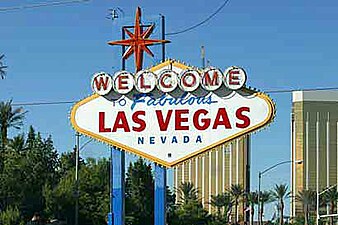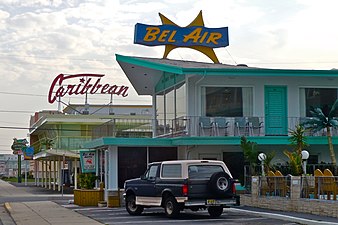古奇建築

古奇建築(英語:Googie architecture)是一種現代建築的形式,屬於未來主義建築的一種,受到汽車文化、噴射機、太空時代和核子時代的影響[1]。
歷史[编辑]
古奇建築在1940年代晚期起源於美國南加州,並延續至1960年代中期,在汽車旅館、咖啡店和加油站建築中十分流行。古奇風格隨後成為世纪中期现代主义的一部份,其中的設計要素反映了當時在美國流行的「populuxe」美學[2][3],埃罗·沙里宁的TWA飛行中心即為一例。
古奇的英文(Googie)原名來自一間現已歇業的西好萊塢咖啡店[4],由約翰·洛特納(John Lautner)設計[5]。古奇建築的近似風格有時又稱作「Doo Wop」[6]。
特徵[编辑]
古奇建築風格的特徵包括向上傾斜的屋頂、曲線的幾何形狀,以及大膽採用玻璃、鋼鐵和霓虹燈。太空時代中象徵動作的設計元素也出現在古奇建築中,包括回力镖、飛碟、原子和抛物线,以及其他自由形態的要素,例如「柔和」的平行四边形等。這些設計風格要素反映了美國社會對太空時代的著迷,以及市場上對未來主義設計的重視與強調。
與1930年代的装饰风艺术相同,古奇風格隨著時間的經過逐漸變得不受重視,許多此一風格的建築也被拆除。而其中保存下來的包括一間最古老的麥當勞餐廳(位於加州唐尼市),已在1983年被列入美國國家史蹟名錄。
例子[编辑]
-
Elm Road 露天汽車電影院
資料來源[编辑]
- ^ Friedlander, Whitney. Go on a SoCal hunt for Googie architecture. Baltimore Sun. Los Angeles Times. 2008-05-18 [2009-02-11]. (原始内容存档于2014-01-06).
It was the 1950s. America was a superpower, and the Los Angeles area was a center of it. The space race was on. A car culture was emerging. So were millions of postwar babies. Businesses needed ways to get families out of their automobiles and into coffee shops, bowling alleys, gas stations and motels. They needed bright signs and designs showing that the future was now. They needed color and new ideas. They needed Googie.
- ^ Stager, Claudette; Carver, Martha. Looking Beyond the Highway: Dixie Roads and Culture. Univ. of Tennessee Press. 2006: 158 [2013-08-09]. ISBN 978-1-57233-467-0.
- ^ Cotter, Bill; Young, Bill. Populuxe and Pop Art. The 1964-1965 New York World's Fair. Arcadia Publishing. 2004: 51 [2013-08-09]. ISBN 978-0-7385-3606-4.
- ^ Nelson, Valerie J. Eldon Davis dies at 94; architect designed 'Googie' coffee shops. Los Angeles Times. 2011-04-26 [2011-05-15]. (原始内容存档于2019-12-10).
- ^ John Lautner (页面存档备份,存于互联网档案馆) Why Do Bad Guys Always Get The Best Houses? by Rory Stott ArchDaily
- ^ Doo Wop Motels: Architectural Treasures of The Wildwoods by Kirk Hastings 2007, p.2
外部連結[编辑]
| 维基共享资源上的相关多媒体资源:古奇建築 |
- Lotta Living(页面存档备份,存于互联网档案馆),一個古奇建築風格愛好者的網路社群
- Googie Architecture Online (页面存档备份,存于互联网档案馆)
- Roadside Peek: Googie Central(页面存档备份,存于互联网档案馆)
- The 1964-1965 New York World's Fair(页面存档备份,存于互联网档案馆)
| ||||||||||||||||||||||||||||||||
| ||||||||||||||||||||||||||||||||||||||||||||||



